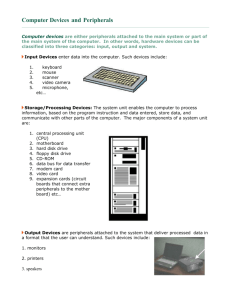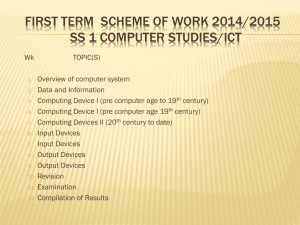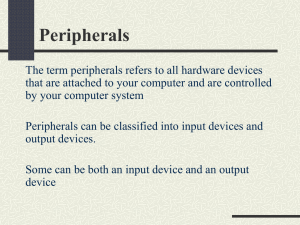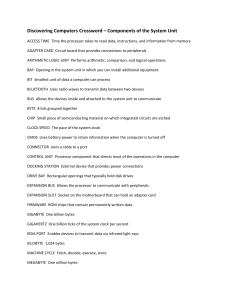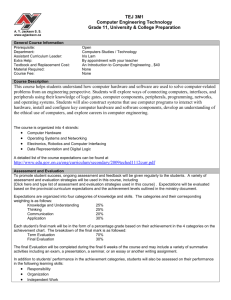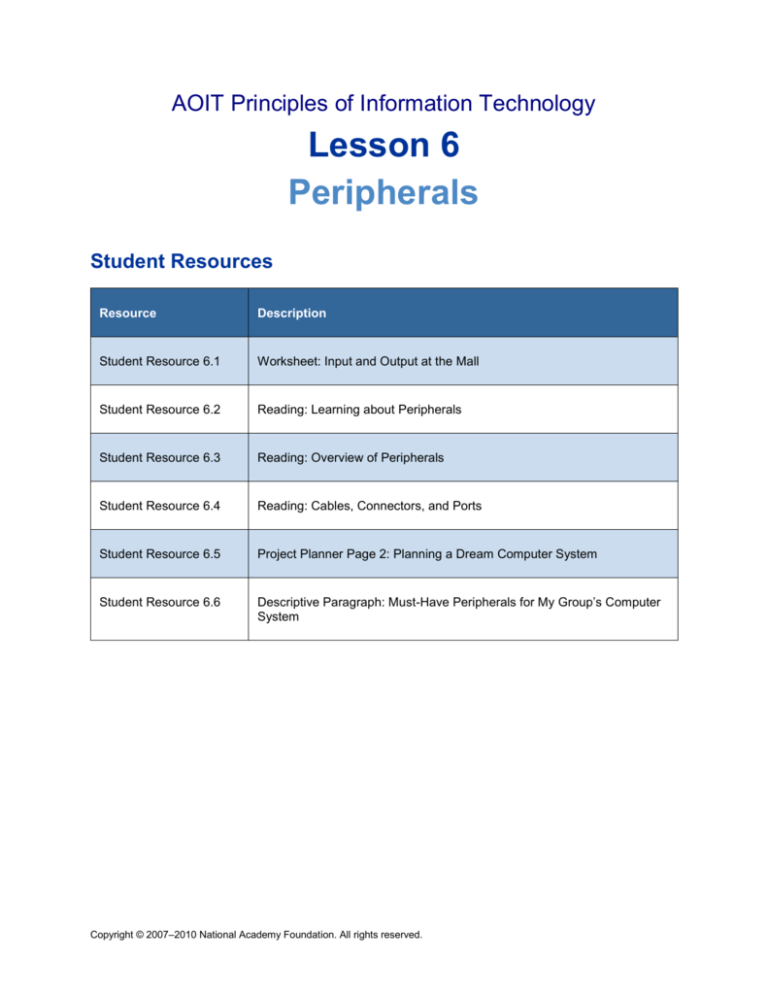
AOIT Principles of Information Technology
Lesson 6
Peripherals
Student Resources
Resource
Description
Student Resource 6.1
Worksheet: Input and Output at the Mall
Student Resource 6.2
Reading: Learning about Peripherals
Student Resource 6.3
Reading: Overview of Peripherals
Student Resource 6.4
Reading: Cables, Connectors, and Ports
Student Resource 6.5
Project Planner Page 2: Planning a Dream Computer System
Student Resource 6.6
Descriptive Paragraph: Must-Have Peripherals for My Group’s Computer
System
Copyright © 2007–2010 National Academy Foundation. All rights reserved.
AOIT Principles of Information Technology
Lesson 6 Peripherals
Student Resource 6.1
Worksheet: Input and Output at the Mall
Student Name:________________________________________________ Date:_____________
Directions: The table below gives some information about different types of computer input devices that
you might find at a large shopping mall. In addition to naming the type of business and the type of device,
describe how these devices are used to make businesses more efficient and to keep you, the customer,
happy. To add other types of devices, use the back of this page or another sheet of paper.
Type of Business
Type of Input/Output Device(s)
Benefit(s) of Device
Game arcade
Bar code readers (input)
Monitors/screen displays (output)
Restaurant with
karaoke
Convenient and fast way to get cash
Document-processing
business, such as
FedEx Kinko’s
Fax machine (input and output)
Keyboards (input)
Various types of printers (output)
Image scanners (input)
Kiosk with touch screen (input and
output)
Copyright © 2007–2010 National Academy Foundation. All rights reserved.
Fast communication and production;
reasonable cost for tasks and items
you don’t need often; can use one of
their desktop computers if you don’t
own one
AOIT Principles of Information Technology
Lesson 6 Peripherals
Student Resource 6.2
Reading: Learning about Peripherals
This presentation introduces many of the peripherals available to consumers today.
Copyright © 2007–2010 National Academy Foundation. All rights reserved.
AOIT Principles of Information Technology
Lesson 6 Peripherals
A peripheral is any device that can be added to a computer to expand its functionality. Examples are
monitors, printers, keyboards, mice, scanners, and disk drives. This presentation shows examples of
each of these devices. Keep what you see here in mind as you work with your group to design the best
computer system possible for your culminating project.
Copyright © 2007–2010 National Academy Foundation. All rights reserved.
AOIT Principles of Information Technology
Lesson 6 Peripherals
PS/2 plugs are older but still found on many pieces of equipment. USB plugs are a newer style.
Copyright © 2007–2010 National Academy Foundation. All rights reserved.
AOIT Principles of Information Technology
Lesson 6 Peripherals
Most wireless mice use radio frequencies (RF) to transmit information. RF wireless mice require two
components: a transmitter and a receiver.
The transmitter is inside the mouse. It sends a signal to the receiver, which connects to the computer
through a USB port or PS/2 mouse port. The receiver can also be an expansion card or it can be built-in.
The signal encodes information about the way you move the mouse and the buttons you click. The
receiver accepts the signal, decodes it, and sends it to the operating system and the mouse driver
software.
Another type of wireless mouse uses Bluetooth RF technology. Bluetooth connects computers wirelessly
to keyboards, printers, and headsets. Bluetooth uses special software to choose frequencies that have
the least interference.
Three mice technologies are common:
•
Mechanical – These mice use a tiny rubber ball to measure movement and position.
These mice are not used anymore because they get dirty easily and process information
slowly.
•
Optical – These mice use optical light to measure movement and position. They are
inexpensive, reliable, and process information quickly.
•
Laser – These mice use laser light to measure movement and position. They are reliable,
fast, precise, and more expensive than optical mice.
Some mice have buttons and include a trackwheel. A trackwheel lets you scroll up and down quickly, so
you don’t have to move your mouse as much.
Copyright © 2007–2010 National Academy Foundation. All rights reserved.
AOIT Principles of Information Technology
Lesson 6 Peripherals
LCD monitors are just like LCD televisions: their images are displayed by liquid crystal display. CRT
monitors are an older style that is less common. Just like older TVs, they have a CRT (cathode ray tube)
that displays the image. Both monitors work well, though LCD monitors have a brighter, crisper picture,
are much lighter weight, and take up considerably less room than CRT monitors.
Copyright © 2007–2010 National Academy Foundation. All rights reserved.
AOIT Principles of Information Technology
Lesson 6 Peripherals
Printers and scanners add enormous value and usability to any computer system. After all, everyone
needs to print sometime.
Many consumers and small offices choose multifunction printers, as shown on the left. An all-in-one
multifunction machine can print, scan, copy, and fax documents.
People who do not need or want all of the functions of a multifunction machine often choose separate
printers and scanners. The printer shown at the top right above is an ink jet printer. Ink jet printers are
usually inexpensive, which makes them attractive to many buyers. They print by spraying tiny droplets of
ink (usually around 600 dots per inch) onto paper.
Laser printers are another printer option. They print by using heat to transfer and attach toner from a
drum to paper.
Scanners (see the bottom-right picture) are used to digitize two-dimensional objects, like photos and
documents.
Copyright © 2007–2010 National Academy Foundation. All rights reserved.
AOIT Principles of Information Technology
Lesson 6 Peripherals
External disk drives give users many options for storing data.
The drives shown on this slide are (clockwise, from upper left):
•
An external hard drive. It works just like an internal hard drive, but is portable.
•
External DVD drive. This optical drive uses optical light to read DVDs and to write (or
“burn”) DVDs full of data. (Slide photo source: http://en.wikipedia.org/wiki/DVD_drive)
•
A USB drive (also called a “thumb drive” or “flash drive”) is a tiny device that can hold up
to 256 GB of data. USB drives that hold 4 or 8 GB can be purchased for under $20.
Copyright © 2007–2010 National Academy Foundation. All rights reserved.
AOIT Principles of Information Technology
Lesson 6 Peripherals
Desktop machines come in many shapes and sizes. Which you choose is largely a matter of personal
preference. Each of these houses a computer’s CPU (its “brain”), but also requires peripherals in order to
be useful. This presentation will give you an overview of the many types and styles of the peripherals
most commonly found in today’s computer systems.
Copyright © 2007–2010 National Academy Foundation. All rights reserved.
AOIT Principles of Information Technology
Lesson 6 Peripherals
Different sized bays are designed to hold different types of equipment, including DVD+/-R/RW and Bluray drives. Most desktop computers have a DVD drive as the primary optical drive; the ability to read and
write to the DVD can be optional. Blu-ray drives are often the secondary optical drive.
Copyright © 2007–2010 National Academy Foundation. All rights reserved.
AOIT Principles of Information Technology
Lesson 6 Peripherals
In the past, floppy disks were the main way users could store and load software.
The picture on the left shows an old 3½ in. floppy drive (which replaced the even older 5½ in. floppy
disks). In time, the CD-ROM drive (shown here in the upper-right corner) replaced 3½ in. floppies. Now,
however, the CD has largely been replaced by the DVD drive (at bottom right). Blu-ray drives (at bottom
left) are the latest technology, and were designed for high-definition audio and video.
This is all good news for computer users. A 5½ in. floppy can hold only 800KB. A 3½ in. disk can hold
1.4MB. A CD-ROM can hold 737MB. A DVD can hold 4.7GB if one-sided or 8.5GB if double-sided. And a
Blu-ray disc can hold five times the amount of data that a traditional DVD can hold, from 50GB to more
than 200GB.
Copyright © 2007–2010 National Academy Foundation. All rights reserved.
AOIT Principles of Information Technology
Lesson 6 Peripherals
Use what you learned in this presentation to start thinking about what peripherals are essential for your
dream computer, and what would be nice to have. Remember that all computers need peripherals in
order to input and output data.
Copyright © 2007–2010 National Academy Foundation. All rights reserved.
AOIT Principles of Information Technology
Lesson 6 Peripherals
Student Resource 6.3
Reading: Overview of Peripherals
What Is a Peripheral?
A peripheral is a device attached to a host computer but not part of it and more or less dependent on the
host computer. Often peripherals attached to desktop computers are outside the case, and connected via
cables or wireless connection. Laptop computers usually have peripherals such as the keyboard, mouse,
and monitor already built in. Peripherals are commonly divided into two groups: input devices and output
devices. An input device is any piece of hardware that is used to enter data into a computer. An output
device is any piece of hardware that “plays back” the result of computer processing in the form of text,
graphics, video, or audio.
Standard Input Devices
The most standard types of input devices are keyboards and pointing devices (such as the mouse and its
variations). With a keyboard, you can type text, select commands, and move around in a document. Most
English-language keyboards use the QWERTY layout, which gets its name from the order of the keys in
the upper-left portion of the keyboard.
A mouse is used to perform tasks such as starting programs, selecting text, and moving and resizing
items. You can point, click, double-click, and drag items on the screen with a mouse. Mouse designs may
differ slightly between manufacturers, but most mice for Windows computers have two buttons. Mice for
Macintosh computers usually have one button. You can even purchase mice operated by remote control,
which are useful for giving presentations.
Variations of the mouse include the trackball and the trackpad. A trackball has a ball on the top of the
mouse. You move the on-screen pointer by rolling the ball. A trackpad (sometimes called a touchpad) is
used by moving your finger around on the pad. Buttons below a trackpad are used for clicking purposes.
Some mice also have trackwheels, a wheel mounted on the mouse that allows users to scroll up and
down within a selected window.
Specialized Input Devices
Input devices for specialized uses can be grouped into several categories: devices that allow people to
use their hands to input data, optical devices that allow computers to use light as an input source, and
devices that relate to audiovisual technologies.
Input Devices Designed for the Hand
A game controller such as a joystick or game pad is a special input device used to play computerized
games. The joystick is a lever that can be moved in many directions to move objects on the computer
screen. Game controllers in the shape of steering wheels provide you with the sensation of driving or
flying through space. Some controllers, such as those for the Nintendo Wii, allow users to work the
controller in a way that mimics the action on the screen.
Touch screens accept information directly through the monitor screen. By touching pressure-sensitive
areas on the screen, you can input data commands.
Many portable computers use special “pens” as input devices. Instead of using ink, this type of pen
(sometimes called a stylus) sends electrical signals through a touch screen. This pen can be used as a
pointing device and, if the computer contains handwriting recognition programs, as a data-entry device.
Handwriting recognition software enables the computer to change writing into digital characters.
Copyright © 2007–2010 National Academy Foundation. All rights reserved.
AOIT Principles of Information Technology
Lesson 6 Peripherals
Optical Input Devices
Many businesses use scanning devices to input data. One of these, a bar code reader, works by
scanning in a bar pattern called a universal product code (UPC). Bar codes are used on the packages or
labels of products you buy. Each product has its own unique pattern. This enables the computer to match
UPC information with product data stored in the computer (such as the item’s price) and display it on the
cash register. Bar code readers are also used to track and locate packages quickly.
Audiovisual Input Devices
Examples of audiovisual input devices include microphones, digital cameras, and digital video cameras.
Digital cameras capture images electronically on special memory disks instead of using film as regular
cameras do. This means that digital cameras can capture and hold a lot more images at one time, and
you don’t need to spend time and money having someone else develop your pictures. Digital photos can
be transferred to your computer where they can be edited, stored, printed, added to documents, or easily
sent to another person.
One way that digital video cameras are used is for videoconferencing. People in different locations can
see each other and discuss business matters as if they were in the same room. Videoconferencing saves
companies a lot of time and money that would otherwise be spent on travel.
Output Devices: Monitors
A monitor is a hardware device that displays information on a screen. There are two main types of
monitors: cathode ray tube (CRT) monitors and liquid crystal display (LCD) monitors.
How Monitors Work
In a CRT, the monitor is built around a vacuum tube that receives electrical signals from the computer.
This causes a stream of electrons to shoot at the back of the screen. These electrons strike materials
called phosphors that glow and appear as points of light on the screen.
LCD monitors are used in portable computers where large and heavy CRT monitors would not be
practical, but more and more of these flat-panel screens are also being used in desktop models. In an
LCD, two transparent surfaces are located on both sides of a layer of cells containing tiny crystals. These
crystals form images on the screen surface when electrical signals are sent to them.
Factors That Affect Image Quality
The quality of an image displayed on a monitor depends on a number of factors, including resolution, dot
pitch, color depth, and screen size.
Resolution refers to the sharpness of a displayed image. A monitor’s resolution is measured with pixels;
the term pixel combines the words picture and element. Resolution is expressed with two numbers: the
number of pixels that the monitor can display across the screen (horizontal), and the number of pixels that
the monitor can display down the screen (vertical). The lowest possible resolution is the video graphics
adapter (VGA) standard, 640 x 480. Most of today’s monitors use Super VGA (SVGA) resolution, which is
1280 x 768 or higher.
The degree of space between pixels also affects the quality of the images displayed on a monitor. This
space is referred to as the monitor’s dot pitch. The smaller the dot pitch, the sharper the image.
The amount of video memory your computer has affects the monitor’s color depth, which is the number of
colors it can display at one time. The more video memory your computer has, the more colors it can
display. This is because more memory allows for more data bits per pixel to be used. For example, with 4
Copyright © 2007–2010 National Academy Foundation. All rights reserved.
AOIT Principles of Information Technology
Lesson 6 Peripherals
bits per pixel, the monitor can show up to 16 colors. But with 32 bits per pixel, the monitor displays more
than 16.7 million colors. Color depth is particularly important when it comes to viewing video.
Screen size is measured from one corner to the opposite corner. Common sizes are 17-inch and 21-inch
monitors. Usually, the area that can actually display images is an inch smaller than the listed size.
Output Devices: Printers
Most printers in use today are nonimpact printers. They do not strike the page in any way but instead use
a variety of other methods to place ink on paper. Two common types of nonimpact printers are inkjet
printers and laser printers.
Inkjet printers contain cartridges of liquid ink that is squirted onto the page. They offer a good mix of
quality and affordability. Inkjet printers offer the least expensive way to purchase a color printer. Keep in
mind, though, that output can sometimes smear if it is touched or dampened shortly after printing.
Laser printers work in a similar manner as copy machines. As the paper is rolled around a drum, toner
from the drum is applied to the paper using heat. Although this printer type may be more expensive than
a comparable inkjet printer, it is dependable, durable, and high quality. You can also purchase color laser
printers, but they are more expensive than black-and-white models and cost much more than color inkjet
printers.
Types of specialized, high-quality printers include photo printers, dye-sublimation printers, and plotters.
Photo printers are popular among people who own digital cameras because they are used to print color
photographs. Dye-sublimation printers (or dye-diffusion thermal transfer printers), often used by
professionals such as graphic artists and desktop publishers, create extremely sharp images by
transferring colored ink to paper with heat. Though they are extremely high quality, they can be slow and
expensive. A specially coated paper is required for both photo printers and dye-sublimation printers.
A plotter is an output device that uses robotic “arms” to draw or “print” large documents such as
architectural blueprints or engineering drawings.
Criteria for Evaluating Printers
When evaluating printers for purchase, you should consider the following:
The print quality the printer provides
How fast it prints
Whether you need to be able to print in color or just in black and white
Whether you need to print on both sides of a sheet of paper (called duplexing)
The initial cost of the printer
The cost of operating the printer
The cost of a printer is related to its print quality and speed. You can find printers that start at around $50
and range upward to several thousand dollars.
Print quality is measured by the number of dots per inch (dpi). Each character or illustration that gets
printed is made up of many tiny dots. The more dpi, the higher the quality. Speed is measured by the
number of pages per minute (ppm) that a printer can produce. As speed and quality increase, so does the
cost of the printer.
Copyright © 2007–2010 National Academy Foundation. All rights reserved.
AOIT Principles of Information Technology
Lesson 6 Peripherals
Devices That Input and Output
A modem is a device that allows computers to communicate through telephone lines. Modems are
typically used to connect to the Internet for dialup connections. A modem is frequently found inside the
computer case, but it can also be external.
Combination or multifunction printers can act like a printer, a fax, and a copy machine. They may also be
able to function as a scanner. Multifunction printers are especially designed for small businesses and
home offices since they are relatively inexpensive.
A kiosk is a freestanding device that has a touch screen people can use to input requests for information;
the information then displays on the screen.
Copyright © 2007–2010 National Academy Foundation. All rights reserved.
AOIT Principles of Information Technology
Lesson 6 Peripherals
Student Resource 6.4
Reading: Cables, Connectors, and Ports
Wireless Technology Goes Portless
Although ports and connectors are featured in almost all computer systems. wireless technology has
reduced the need for cables, connectors, and ports in many situations. Wireless keyboards and mice are
available, as are wireless networks. Wireless technology is convenient, and obviously reduces the clutter
caused by too many cables. Wired technology, however, will continue to serve certain purposes, such as
providing extra security and reliability.
How Ports Are Used
Peripherals need to be connected to the computer so that data can be transferred back and forth.
Peripherals are sometimes joined to a computer case using a cable—a group of wires inside a protective
tube. Each cable has a plug, called a connector, on the end. This connector is inserted into a slot, called
a port, which is usually located in the back of the computer. Ports are also referred to as interfaces. In
other words, a port is a place where a connection is made between two devices so that they can work
together and exchange information.
Types of Connectors
There are two basic kinds of connectors: male and female. A male connector has one or more exposed
pins. A female connector has one or more sockets designed to accept the pins on the male connector.
Types of Ports
There are three main types of ports: serial, parallel, and multidevice. Serial ports move data one bit at a
time. A serial port is often used to access the Internet by connecting the computer to telephone lines.
Parallel ports move bits in groups simultaneously. A parallel port is often used to connect a printer to a
computer. As you would expect, a parallel interface can handle a much higher volume of data than a
serial interface.
Multidevice ports can connect several peripherals to a computer through a single port. An example of this
type of port is the small computer system interface (SCSI), pronounced “skuzzy.” A universal serial bus
(USB) is another example of a multidevice port that works in a similar manner. A third variety is IEEE
1394, commonly known under the brand name FireWire, a port originally found on camcorders but now
common on all types of peripherals.
Instead of forcing the user to plug multiple expansion cards into the computer’s expansion slots, a SCSI
or USB adapter extends the computer’s bus outside the case via a cable. Think of a multidevice adapter
as an extension cord for the data bus. This enables you to plug one peripheral into another to form a
chain—a process called daisy chaining. Some SCSI, USB, and FireWire devices can link more than 100
peripherals in this way. If you need to link even more USB or FireWire devices together, you can do so by
using a hub.
Copyright © 2007–2010 National Academy Foundation. All rights reserved.
AOIT Principles of Information Technology
Lesson 6 Peripherals
Image courtesy of Coolnerds.com
http://www.coolnerds.com/Newbies/Ports/ports02.jpg
Types of Cables
As mentioned previously, SCSI, USB, and FireWire ports enable users to connect many kinds of devices
not only to CPUs but also to each other. The cables used to connect these devices are named for the
type of port they connect to (SCSI cables, USB cables, and FireWire cables). Though all of these cables
move data from one device to another, they do not do this at the same speed.
SCSI cables are always “female” on both ends and connect to SCSI devices. Though SCSI was once a
common way to transfer data quickly on Macintosh computers and was one of many ways to transfer data
on Windows computers, it is slow by today’s standards and is no longer used on new hardware.
USB was introduced in 1995 as an alternative to SCSI and remains a popular connection style. The
standard for USB these days is called USB 2.0 and is 40 times faster than the original USB transfer
speed. FireWire 400 is similar in speed to USB 2.0.
Copyright © 2007–2010 National Academy Foundation. All rights reserved.
AOIT Principles of Information Technology
Lesson 6 Peripherals
Student Resource 6.5
Project Planner Page 2:
Planning a Dream Computer System
Student Names:_____________________________________________ Date:_______________
Directions: This is the second part of the project planner that you will use to help plan your group’s dream
computer system. In future lessons, you will add items such as operating system, productivity software,
and software you need for activities such as creating graphics or listening to music.
Fill in the spaces below to identify and plan for the peripherals you will buy for your dream computer
system. List what you would buy and the reasons why you have chosen each item for your system.
Remember to include all peripherals you will need, from the most basic to the most highly specialized.
When telling about the peripherals you would choose, don't worry about specifics such as model
numbers, the exact keyboard you’d choose, or monitor size. You will be able to return to this later and
make specific decisions about these elements as your other plans for the system take shape.
What this computer will be used for:
Primary peripherals and use:
Secondary peripherals and use:
Reasons for these choices (you will be allowed to change your mind as you work):
.
Copyright © 2007–2010 National Academy Foundation. All rights reserved.

